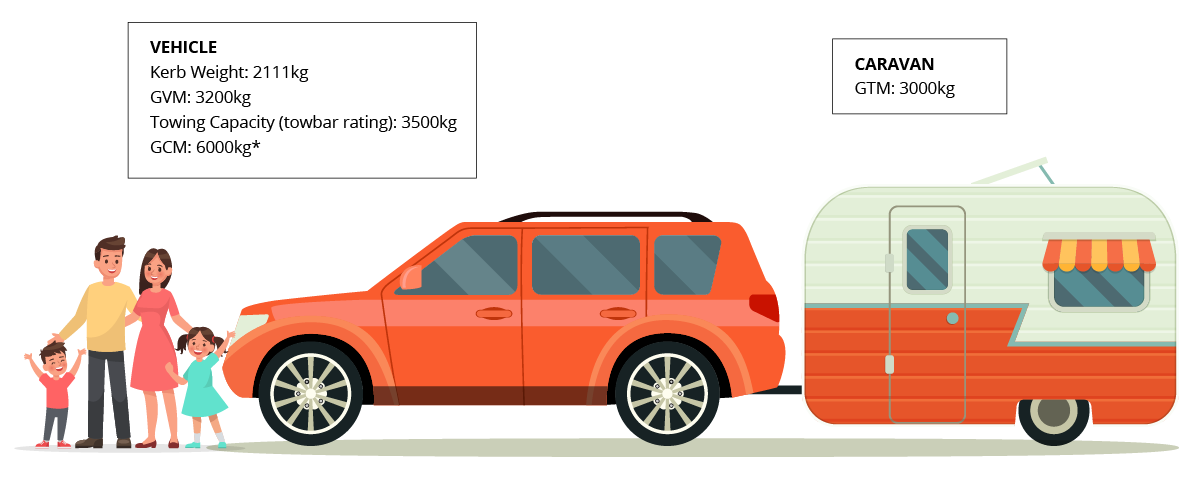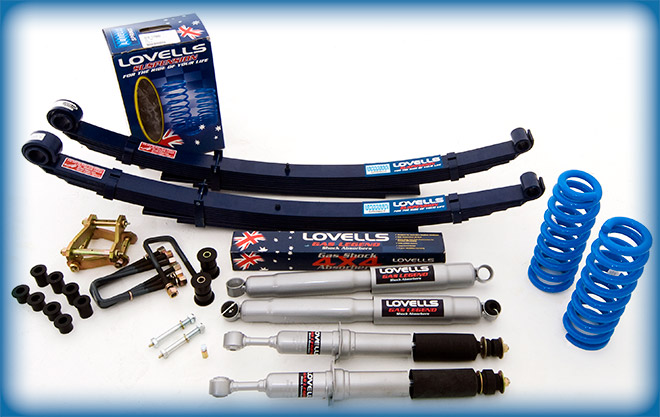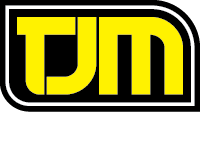There’s been a bit of a hoo-ha around GCM and GVM in the world of 4WD and towing lately, including the recent announcement of the decision by the South Australian Government to reverse their ban on the installation of after market towing upgrades by certified Second Stage Manufacturers.
But what do GCM and GVM actually mean? What about towing capacity and GTM? What can I do about it and what are the consequences if I don’t do anything?
Note: The following is designed to be a guide only. Please contact the experts at TJM and they will talk you through your particular situation.
GVM (Gross Vehicle Mass)
The Gross Vehicle Mass (GVM) is the maximum your vehicle can weigh and is specified by your car’s manufacturer – you’ll usually find this in the plaque in the driver’s door-well, or in your owner’s manual. The weight indicated includes everything in and on your vehicle … you, your passengers, bullbar, tools, fridge, luggage, fishing gear, kitchen sink … as well as your tow ball weight.
Tip: know what your kerb weight is! Your kerb weight is what your vehicle weighs when it’s empty and in its ‘brand new’ state with no additions. If your vehicle weighs in at 2000kg and your GVM is 3200kg, then you know you’ve got 1200kg of load up your sleeve when you start adding accessories and fittings, but remember the more you add here, the less you can tow (read on to find out why).
Towing Capacity
This number is the maximum weight that your vehicle is recommended to tow and is specified by the manufacturers according to their engineering approvals. To complicate things, this capacity is dependant on the rating of your towbar; if your vehicle is rated to tow 3500kg but your towbar is only rated 2500kg, then you should go by the lower number.
GCM (Gross Combination Mass)
The Gross Combination Mass (GCM) is the maximum that everything can weigh. Once upon a time your GCM was simply calculated by adding your vehicle’s GVM to its towing capacity. Not anymore! Manufacturers are now specifying what your GCM is and it’s what the authorities are using to determine if you’re over the limit or not! This critical number can also be found in the driver’s side door-well.
GTM (Gross Trailer Mass)
The maximum your trailer can weigh fully laden with any gear, water, gas bottles, annexe etc. This will be specified by your trailer manufacturer.
An (almost) real-life scenario
John and Judy are about to take to the road with their two children. They’ve bought an SUV and are going to kit it out with a bunch of items to make their trip more comfortable and enjoyable and their vehicle more efficient and safe.

Their setup has the following details:
Vehicle:
Kerb Weight: 2111kg
GVM: 3200kg
Towing Capacity (towbar rating): 3500kg
GCM: 6000kg*
Caravan:
GTM: 3000kg
*Note that the vehicle manufacturer has specified a GCM that is 700kg less than the sum of the GVM and Towing Capacity!
John has decided to add a bullbar, winch, a long-range fuel tank, sidesteps and drawers to his vehicle so now his kerb weight has increased significantly. Now add tools, luggage, kayak, roof rack, fridge, 2 adults, 2 children, booster seats and bikes and he’s seriously nudging – perhaps exceeding – his GVM.
As they’re hitting the road long-term, their van is fully packed and is pretty close to their GTM of 3000kg. Therefore his current GCM is well in excess to 6200kg … more than what his vehicle specifies and he’s in danger of fines, or worse, an accident!
What’s the solution?
There’s no need to trade in your vehicle for a Monster Truck. GVM and now GCM can now be upgraded through TJM South Australia
You can get a GVM upgrade using a certified compliant Lovells Upgrade kit fitted to most SUV’s. These will give you 300-500kg (depending on your vehicle make and model) of extra vehicle mass so that you can safely add some extra bits and pieces to your packing or rig.
Further to this, the recent backflip by the SA Government means that “GCM revision and towing upgrades can [also] be done on pre-registered vehicles by Second Stage Manufacturers with applicable evidence packages” (Media Release 16 September, 2019 – Lovells Springs). TJM is an authorised installer of Lovells GCM upgrades and compliance testing and certification is provided by an authorised State Engineering Signatory.
In their recent Media Release announcing their win to have the ban on GCM upgrades overturned, Lovells General Manager Mike Davison said: “Without an increase in legal towing capacities, many people towing caravans or trailers have been unknowingly breaking the law and voiding their insurance”. Not a good scenario for thousands of 4WD-ers across the state.
Do I need to upgrade?
The answer to this question will vary greatly depending on your vehicle (make, model and year), how many additions or modifications you’ve made (or are about to have made) and what you’re going to tow.
We recommend you visit your local TJM store and speak to one of our experts who can go through your specific scenario and make a recommendation that’s right for you.
Do you have questions or comments about GVM and GCM? Leave them below and we’ll do our best to answer them.
Related products
Lovells GVM Upgrades

Make an enquiry
Share this Post



25 Comments on “What you need to know about GCM and GVM upgrades now”
Hi. I had TJM install a Lovell’s GVM/GCM upgrade on my BT50 prior to first registration. I note that I have a 2nd stage compliance sticker for the the GVM but nothing for GCM, does this situation now change?
Regards
Martin
Thanks for your comment Martin, to make sure we give you the best guidance on this please contact Don or Craig at TJM Nailsworth on (08) 8344 6444 and they will talk you through it.
Great to see that information is coming out about the changes to GCM upgrade and the article explains this well. I note though that the article does not include information about the tow ball weight limit attributed to vehicles by manufacturers eg. Pajero limits vary according to weight towed. Perhaps this could also be pointed out in the next article. Otherwise well done.
Thanks for the comment and your encouragement Yvonne! Tow ball weight limits certainly add to the equation. For the sake of this article we tried to keep things simple – as you’ve pointed out it can vary per vehicle by the weight towed, so it would be impossible to cover it all in one article. We always encourage you to talk to the experts at TJM for the full picture for your individual case.
Your story above references pre registered vehicles do you actually mean post registered vehicles ie as referenced in the Lovells media statement “in service vehicles”?
Hi Greg, thanks for taking the time to read both articles so thoroughly. The section you refer to is a direct quote from the Lovells press release and refers to this statement:
“The State and Territory jurisdictions cover in-service vehicles – those that have left the showroom floor. In line with the current Australian Design Rules, GCM revision and towing upgrades can be done on pre-registered vehicles by Second Stage Manufacturers with applicable evidence packages.” I hope this answers your query.
Unfortunately my original suspension upgrade (as a TJM ‘demo’ vehicle) was a failure. Rated capacity quoted not what was installed and 6 leaves one side and 7 the other! All my dealings with various dealers (in SA) on this issue and other items have demonstrated a poor skills base and little technical knowledge – and almost zero accountability. Now that I am in need of a GVM upgrade, I will surely go to Lovell’s…..but never to TJM! Just a little tip for all to shop around and review the workmanship before handing over the cash!!!
Sounds like you have had a bad experience. We would like to know more details from you as much has changed at TJM in recent times and we are all about customer service and assisting with advice and issues. Please contact co-owner, Don, or our General Manager, Craig, on 8344 6444 to discuss further and to see how we can get things sorted.
I was very interested to see this artical as the GQ Patrols are a classic example of this issue.
We’re glad you found the article useful!
Your definition of GTM for trailers is not correct. Gross Trailer Mass is the mass which the trailer wheels exert on the road. This is what the police will check if they weigh your vehicle on the road. The GTM does not include the towball weight, which is included in the ATM, Aggregate Trailer Mass, which you have not mentioned in the article.
I know this is complicated, but it is critical for people to understand. The ATM is what needs to be used to check if the trailer is within the BTC, Braked Trailer Capacity, of the tow vehicle specified by the manufacturer. The towball weight needs to be accommodated within the tow vehicle GVM limit as this portion of the ATM is transferred to the tow vehicle.
The easiest way to check all of this is to take your vehicle with trailer attached to a garden centre weigh bridge (small fee may be charged). Do not unhitch the trailer as this is not necessary and is not what the police will ask you to do on a roadside check.
If you use a weight distribution hitch system this should also be fitted and tensioned correctly as this will redistribute some weight from the tow vehicle rear axle to the front axle. Driver and passengers should stay in the vehicle.
Weigh the vehicle and trailer in the following sequence:
1. Vehicle front axle only.
2. Vehicle only with both axles on weigh bridge. This is the GVM of the vehicle with trailer attached.
3. Vehicle rear axle only, plus trailer axles on weigh bridge.
4. Trailer axles only on weigh bridge. This is the GTM for the trailer.
This process is relatively quick and easy and does not hold up the queue at the weigh bridge.
To calculate weight on the tow vehicle rear axle subtract GTM from the weight recorded at step 3.
A GVM upgrade will usually also specify the new front and rear axle weight limits. You should check that the rear axle is not overweight with the trailer attached. This is where a weight distribution hitch can help.
If you wish to measure the towball weight on the tow vehicle, disconnect the trailer and weigh the vehicle only. Subtract this weight from the weight recorded at step 2.
The Lovells website has good info on all of this as well.
I have had a GVM Lovells kit upgrade on our new Toyota Land Cruiser 200 (before rego) in Nov 2018. The suspension upgrade performs beautifully, I am really impressed with the performance both towing and driving the vehicle only both on and off road. I was aslo very happy with the service and support from TJM at Nailsworth. At that time TJM Nailsworth were the only authorised installer for the Lovells kit in SA under the second stage manufacture process for new vehicles which is approved by the Federal Govt Dept of Transport, which provides Australia wide compliance.
Hi Lloyd, Thanks for your kind words about your experience with TJM Nailsworth and for your contribution to our article – you’ve obviously done a lot of research!
Thank goodness for this light at the end of a long tunnel. I recently spent hours and hours trying to find somewhere to have the ATM of my trailer assessed without any result, The changes to government regulations appear to have occurred after I was searching. Thank you for the article and the SA contact in TJM
We’re glad we were able to shed some light on the subject!
It’s helpful that you said the passengers are included in the GMV because that means you’re going to need a lot more weight allowance than you think. I’m getting an RV so my family can go on a road trip in the spring. I’ll make sure that we have a car that can handle the RV and our weight.
It is interesting that this post explained the weight limit of towing depends on the rate of the towbar that has been approved by engineers. My brother is thinking of upgrading his towing capacity. Before he does, I will advise him to speak with a trained mechanic so that he understands the weight capacity.
Great idea Kristofer. Glad we could provide some helpful information!
How does your GCM increase apply when by my definition of reading this federal document (Section 10 & 10:6 in particular) where it states no aftermarket supplier can upgrade GCM as it is not endorsed or approved by the commonwealth.. .. https://www.infrastructure.gov.au/…/20191003-0-4-6… Excerpt: 10.6 There are no ADRs that require the gross combination mass (GCM) of a light vehicle to be
certified by testing or evidence from a manufacturer. Therefore, the Commonwealth does not assess,
approve or endorse any purported change to light vehicles’ GCM specifications by second stage
manufacturers. State or Territory laws may impose requirements relating to changes to a vehicle’s
GCM specifications.
Thanks for your comment. You are right in your assumption that the Federal government does not ‘endorse’ GCM or GVM upgrades as such; the fact sheet supplied on the federal infrastructure website states:
Gross Combination Mass: The department does not assess, endorse or approve GCM or purported changes to GCM for light vehicles as part of an Identification Plate Approval. Rather, it is up to State or Territory authorities to decide the circumstances in which a person can specify/modify a vehicle’s GCM for the purposes of their legislation.
https://www.infrastructure.gov.au/vehicles/files/20191003-Fact%20Sheet%20-GVM%20Upgrades%20to%20light%20vehicles%20using%20Second%20Stage%20of%20Manufacture.pdf
This article on the same website issues a further clarification:
The revised circular applies to new applications and new amendments to existing Identification Plate Approvals (IPAs). The Circular will not affect the existing IPAs held by the second stage manufacturers. Existing IPA holders can continue to supply to the market vehicles covered by the approved Road Vehicle Descriptors (RVDs). This includes vehicles where the approved RVD has variants that exceed the first stage manufacturer’s Gross Combination Mass (GCM) rating or Rated Towing Capacity or Maximum Braked Towing Mass rating. The second stage manufacturers need to ensure that the current approved RVDs should refer to the current approved RVDs for the first stage manufacturer.
The option of GCM or towing capacity upgrade may be available to consumers in some State/Territory jurisdictions, after the vehicle is supplied to the market.
https://www.infrastructure.gov.au/vehicles/certification/new.aspx
Our article relates in particular to South Australian Government legislation that allows upgrades to be applied.
I hope that clears up any confusion or concerns you might have.
Nowhere in your article do you mention “warranty”.
When asked about a GVM upgrade for a Prado, my local Toyota dealer told me that the warranty is void if you exceed the standard towing capacity. So as far as Toyota warranty is concerned, any GVM upgrade is a total waste of money, time an effort. Pity your article didn’t address this.
Hi John,
Thanks for the question. Each vehicle manufacturer has different warranty policies which are beyond our control. TJM do, however, warrant all work carried out on a vehicle in line with the parts manufacturers’ warranties.
After the gcm upgrade is completed what is involved in the vehicle inspection?
Hi Ray, great question. The vehicle is inspected and signed off by a contracted specialist engineer; this is done at TJM and is included in the service price of the GCM upgrade. I hope this helps?
Please some one help me . At wits end with weights. I have a caravan which is 3,400 Kgs / 3,500 Kgs fully laden. I am purchasing a 200 Series 2021 GXL Landcruiser. What sort of upgrade if any do I need on the Landcruiser?
Hi Stan,
Can I suggest that you contact the team at the TJM Nailsworth store on 08 8344 6444 to discuss your particular scenario? There are a number of variables that need to be considered and it would help to talk them through.